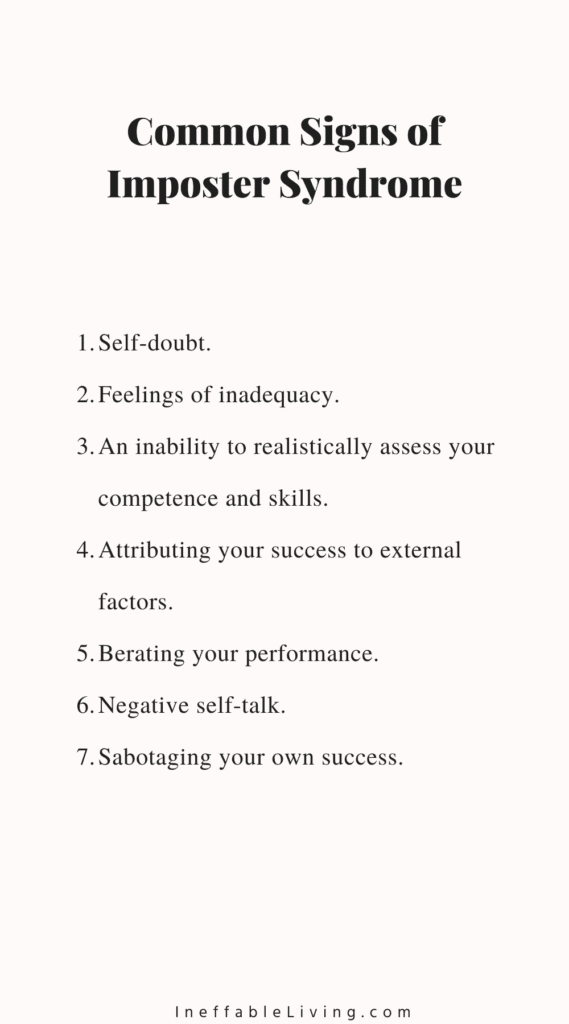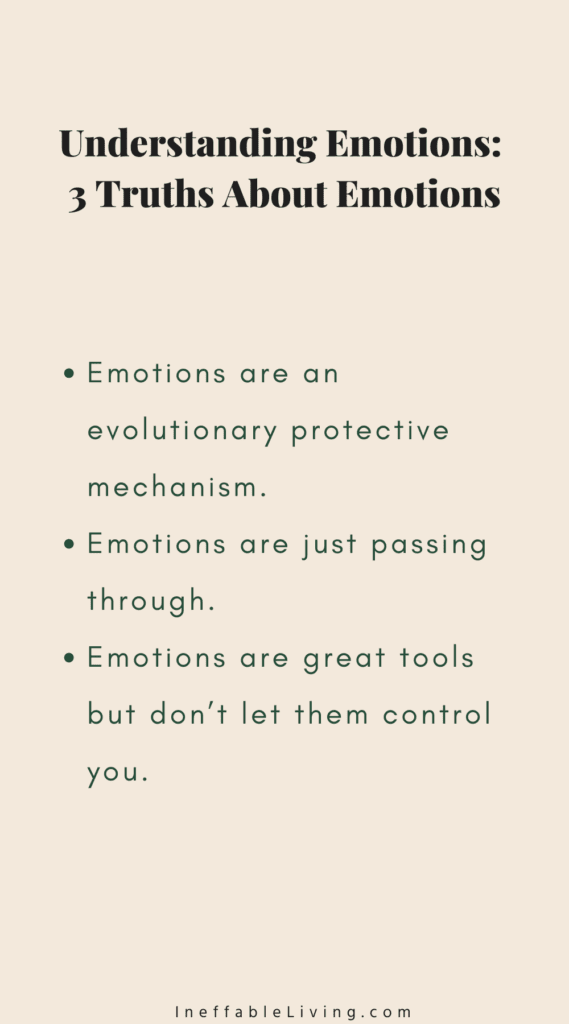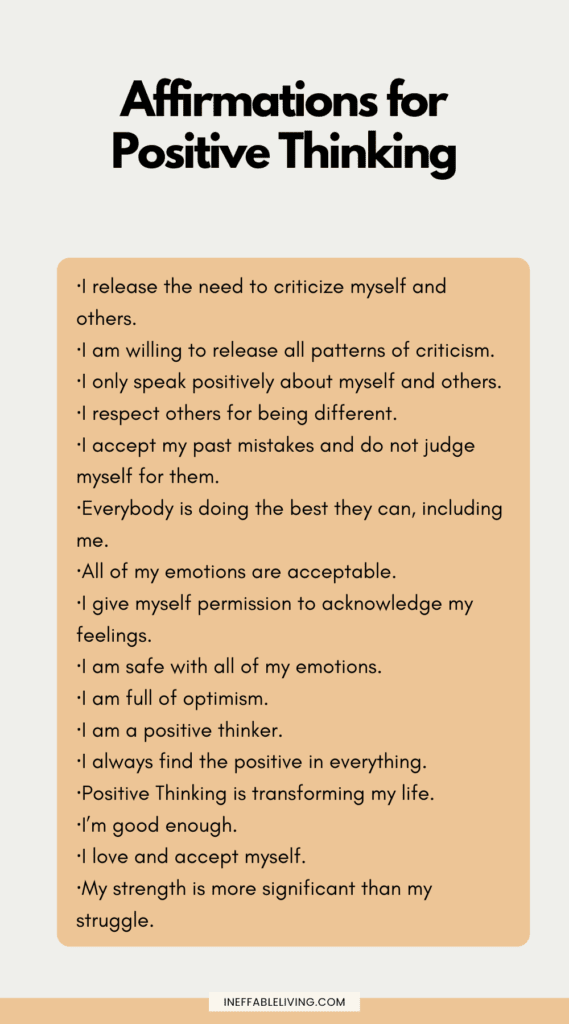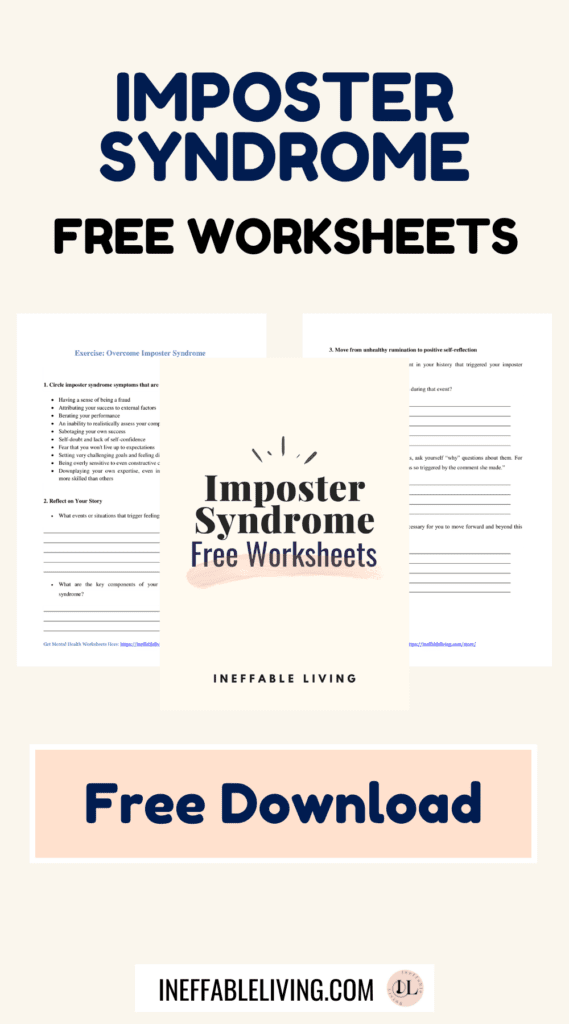This post contains powerful 11 imposter syndrome exercises to help you stop feeling like a fake.
What Is Impostor Syndrome?
Imposter syndrome, also known as “fraud syndrome” and “impostor phenomenon,” is the mismatch between internal beliefs about oneself and the external evidence and outside viewpoints about you. (*)
Research shows that 70 percent of all people have experienced the Impostor Phenomenon at some point in their lives. (*)
People with impostor syndrome under-appreciate and under-value their own talents and skills.
At the same time, they are good at hiding behind an image they present to the outside world, in a way that even their closest friends may not be aware of how internally plagued with self-criticism and self-doubt they can be.
Despite how perfectly normal they look on the outside, people with impostor syndrome can become fragile and brittle under stress, making it hard to bounce back. Despite often being high-achieving people, they become nearly incapacitated by under-estimating their own performance and skill. (*)
As a result, people with impostor syndrome engage in either overworking or self-sabotage.
What Imposter Syndrome Sounds Like
Impostor syndrome plagues many high achievers.
It holds us back by making us too scared to say yes to opportunities.
It leaves us full of self-doubt to trust our own skills and talents.
Imposter syndrome sounds like:
- “I don’t want to be presumptuous. Who am I to tell people what to do? I don’t even know what I am doing!”
- “I don’t have the training or expertise to apply for that job.”
- “I’m not ready for that high-level position. There are so many people who would be better than me.”
- “Even when I have something important to say, I feel like I am the last person that anyone would want to hear from.”
The Spectrum of Impostor Syndrome
Impostor syndrome exists at one end of the self-appreciation spectrum while at the other end sits what could be referred to as “self-over-appreciation.”
This end of the spectrum is characterized by arrogance, egotism, or (in the extreme case) even narcissism.
Somewhere in the middle lies appropriate and realistic self-appreciation. Where a person can acknowledge their contributions and competencies, while at the same time recognizing their weaknesses as opportunities for continuous growth.
Some people with impostor syndrome believe that, the alternative to their under-appreciation would be the other end – becoming unbearable jerks.
That’s unlikely to happen. Moving away from impostor syndrome toward the middle of the spectrum takes a lot of effort and energy and you’ll always have impostor tendencies if you take your eye off it for a moment.
Hallmarks of Imposter Syndrome
Clance and Imes noted that there were four particular hallmarks of impostor syndrome:
1. Diligence And Hard Work – People with imposter syndrome use hard work and diligence as a cover-up for their perceived inadequacy. Receiving praise may result in feeling good, but these feelings don’t last for long thus the cycle begins again.
2. Intellectual Inauthenticity – People with imposter syndrome would downplay their knowledge, skills, or abilities, further exacerbating the feelings of being fraudulent.
3. Charm And Perceptiveness – Those with impostor syndrome often utilize charm and perceptiveness to get people to like them and potentially advocate for them.
4. Seeking Mentorship For The Purpose Of External Validation – Even when they get external approval, a person with impostor syndrome believes it’s undeserved because they charmed the mentor into positive feedback.
Do I Have Impostor Syndrome?
Experiencing self-doubt and questioning your competence when you are trying something new or are in over your head, is normal. These are healthy adaptations that help prevent potentially bad consequences of over-confidence.
So, at what point does importer syndrome begin?
The answer can be found in looking at the frequency, duration, and intensity of feelings of self-doubt and self-criticism. In other words:
* When self-doubt and self-criticism become constant and pervasive,
* When these feelings become incapacitating, holding you back from pursuing new challenges,
* When these feelings keep you from having satisfying experiences and celebrating achievements.
More importantly, are these feelings really justified?
Answering this question can be really tricky since everyone who has impostor syndrome believes there is a solid foundation for their self-doubt and self-criticism, even in the face of considerable external objective evidence of their competency and skills.

Best 11 Imposter Syndrome Exercises
#1. Change Your Narrative
Our narrative about ourselves and the world around us has a great deal of power in keeping impostor syndrome central to our identity or freeing us from it.
When you keep telling yourself that you were just lucky or that a mistake was made, or that no one else really wanted the role, you fill your mind with doubts and enable the impostor syndrome beliefs to stay intact.
Changing your narrative requires identifying the distortions in your story, acknowledging your achievements and strengths, and claiming a more positive, and balanced story.
Reflect on Your Story
Ask yourself what’s triggering feelings of being an imposter? What are the key components of your story that feed your impostor syndrome? Try to list as many as you can.

#2. Develop Self-Awareness
1. Label Your Emotions
Emotional self-awareness is the ability to recognize and identify the emotional experiences you are having.
People with impostor syndrome tend to generalize about emotional states, using surface-level words, like “angry” and “happy,” which don’t illustrate the depths of their emotions.
Noticing and naming your emotional state helps you discover what is actually driving your emotional state and address it more effectively.
The process of labeling your emotion and cognitively interpret it will help you experience less intense and more short-lived strong emotions.
Here is a list of emotions to help you identify your emotions better:
| Anger |
| Disgust: Contempt, disgust, revulsion Envy: Envy, jealousy Exasperation: Exasperation, frustration Irritation: Aggravation, agitation, annoyance, grouchiness, grumpiness, irritation Rage: Anger, bitterness, dislike, ferocity, fury, hate, hostility, loathing, outrage, rage, resentment, scorn, spite, vengefulness, wrath Torment: Torment |
| Fear |
| Alarm, fear, fright, horror, hysteria, mortification, panic, shock, terrorNervousness: Anxiety, apprehension, distress, dread, nervousness, tenseness, uneasiness, worry |
| Joy |
| Cheerfulness: Amusement, bliss, cheerfulness, delight, ecstasy, elation, enjoyment, euphoria, gaiety, gladness, glee, happiness, jolliness, joviality, joy, jubilation, satisfaction Contentment: Contentment, pleasure Optimism: Eagerness, hope, optimism Pride: Pride, triumph Relief: Relief Zest: Enthusiasm, excitement, exhilaration, thrill, zeal, zest |
| Love |
| Affection: Adoration, affection, attraction, caring, compassion, fondness, liking, love, sentimentality, tenderness Longing: Longing Lust: Arousal, desire, infatuation, lust, passion |
| Sadness |
| Disappointment: Disappointment, dismay, displeasure Neglect: Alienation, defeat, dejection, embarrassment, homesickness, humiliation, insecurity, isolation, insult, loneliness, neglect, rejection Sadness: Depression, despair, gloom, glumness, grief, hopelessness, melancholy, misery, sadness, sorrow, unhappiness, woe Shame: Guilt, regret, remorse, shame Suffering: Agony, anguish, hurt, suffering Sympathy: Pity, sympathy |
| Surprise |
| Amazement, astonishment, surprise |
2. Distance Yourself From Your Emotions
Labeling our emotions helps make them less intense and more short-lived. But be aware not to label yourself as your emotions or to internalize your emotions as the truth.
Expressing your emotions as your identity, gives them way too much power over you.
By distancing yourself from your emotions, you recognize that emotions are meant to be fleeting and temporary.
Start Using “I Am Feeling” Statements Instead of “I Am” Statements
A very simple way to distance yourself from your emotions is to start using “I am feeling” statements instead of “I am” statements and to put a time constraint on them.
For example, instead of saying “I am anxious,” start saying “I am feeling anxious right now.”
Refer To Yourself In The Second Person Or Even The Third Person
Another language shift that can help you distance yourself from your emotions is to refer to yourself in the second person (“You are feeling anxious right now”) or even the third person (“[my name] is feeling anxious right now”).
Using the third person in your self-talk might sound a little strange but studies have shown that doing that reduces negative interpretations of emotional events.
Related: 6 Simple Ways to Manage Difficult Emotions and Control Them
#3. Regulate Your Emotions
1. Be Aware Of Your Flight-Flight-Freeze Reactions
People with impostor syndrome tend to have a hard time with emotional self-regulation.
Their intense negative emotions can easily overwhelm them, resulting in flight-flight-freeze reactions. Instead of recognizing these emotions as temporary and fleeting, they over-interpret them as truth.
Over time, impostor syndrome leads to an oversensitivity that even slightly negative events can be perceived as insurmountable threats.
2. Distract Yourself
There are many ways to decrease this hyperactivity. One way is to distract yourself.
The brain is really only good at doing one thing at a time. This means that keeping your brain busy with thinking tasks will decrease hyperactivity.
Some ways to distract yourself include:
- Doing some math: Count backwards from a random large number by sevens. For example, starting at 685 and doing the math in reverse in your head: 678, 671, 664, ….
- Doing a puzzle: Do a Sudoku, or crossword puzzle, or any other game that requires engaging your brain.
- Naming and noticing games: Pick a letter and name all the cities you can think of that start with that letter.
- Read a book or watch a funny movie

#4. Exert Self-Control
Emotional self-regulation and self-control are especially challenging for people with impostor syndrome.
Developing the ability to consciously control how, when, and where you express emotions can help reduce emotional oversensitivity.
Poor emotional self-control comes out in many forms.
It can come out as yelling and screaming at people but it can also come out in not so obvious ways, such as crying at work out of frustration, withdrawing after receiving criticism, etc.
When our emotions overwhelm our senses, this is called “flooding” – an emotional overload.
These inadequate emotional expressions can be devastating to our reputation.
How to exert self-control?
1. Practice Mindfulness
“Mindfulness is purposefully settling into a state of conscious attentiveness and nonjudgmental acceptance of your present moment’s internal and external experiences.” – Jennifer Hunt
Practicing mindfulness has been proven to help regulate emotional distress.
Some of the best indicators of the emotions we’re experiencing are our physical signals. By tuning in to your physical sensations, you can develop greater awareness of your emotions.
1. Take a few moments to be still and enter the world of being rather than doing.
2. Begin this exercise by focusing on your breath and feeling into your body and mind and simply allowing any thought, emotion, or physical sensation to just be.
3. You don’t need to judge, analyze, or figure things out. Spend about three minutes simply checking in with yourself.
Apps like The Mindfulness App, Headspace, Calm, and buddhify can help introduce you to mindfulness and silent meditations.
2. Deep Relaxation and Breathing Exercise
Deep relaxation and breathing exercises can help you regain your composure after a stressful or emotionally charged event.
Progressive Muscle Relaxation
This is when you relax your muscles through a two-step process. You begin by systematically tensing particular muscle groups in your body, such as your neck and shoulders. Then you release the tension and notice how your muscles feel when they are relaxed.
- Lie down in a comfortable position on your back.
- Begin by focusing on a target muscle group—your legs, for instance. Take a slow, deep breath and squeeze the muscles as hard as you can for about five seconds. It’s important to really feel the tension.
- Next, quickly relax the tensed muscles. After a few seconds, you should feel all the tension flow out of your muscles, and they will become loose and limp.
- Deliberately focus on the difference between the tension and the relaxation. This is the most important aspect of this exercise.
- Remain in this state for fifteen to thirty seconds, and then move on to the next muscle group and repeat steps 2 and 3.
- Systematically move through every muscle group of your body.
Deep Breathing
Breath work helps you manage stress of all levels and varieties and bring you back to the present moment.
1. Try doing this exercise lying down on the ground and notice how that provides a sensation of being grounded to the earth.
2. Place one hand on your stomach and the other on your heart.
3. Inhale deeply through your nose as you silently count to three.
4. Exhale through your mouth as you silently count to six.
5. Repeat this six more times, and then see if you can work up to a four-count inhale, followed by an eight-count exhale, and then a five-count inhale, followed by a ten-count exhale.
Once you’re done, notice how you feel calmer and more present.
Apps like Prana Breath, MindShift CBT, Breath Ball, and Health through Breath can help make breathing exercises easier.
#5. Take Control Over Your Inner Critic
The inner critic of people with impostor syndrome is pervasive and destructive. The voice is usually mean and full of believable lies.
Over time, lack of control over this inner critic can lead to self-loathing and increased self-doubt that erodes confidence and self-esteem.
Studies have shown that changing your self-talk alone can lower your blood pressure and boost your mood.
For example, consciously relabeling your “anxiety” as “excitement,” has been shown to improve performance in all types of activities.
1. Distance Yourself From Your Negative Self-Talk
Using “I” statements in your negatively charged self-talk, prevents you from separating your identity from your judgments about behaviors.
Studies show that using second- and third-person statements in self-talk can give you enough distance to treat yourself more kindly, like you would another person.
2. It’s Not About Inundating Yourself With Bland And Meaningless Positive Affirmations
Generic positive self-talk doesn’t work very well when trying to improve your self-confidence.
It might work for people with already high self-esteem, but it doesn’t have much effect on people starting out with low self-esteem.
3. Aim For Higher Ratio of Positive-To-Negative Statements
The best ratio is two-thirds positive and less than one-third negative.
If you aim for that ratio, you’ll be in a zone that is associated with low anxiety and good stress coping.
Related: 10 Powerful Techniques To Control Your Negative Thoughts
#6. Move From Unhealthy Rumination To Positive Self-Reflection
Self-reflection is our way to learn from our past experiences.
But when self-reflection becomes circular and non-directional or starts following you beyond your journaling effort or your self-reflection time, it turns into rumination.
Rumination keeps you stuck and feeds your self-doubt.
Here are some ways to move from unhealthy rumination to positive self-reflection:
1. Consciously take some time to recall a specific event in your history. Focus on the positive aspects of that event and ignore any negative elements.
2. Recall the direct experience of the emotions you had during that event without analyzing the cause or finding a deeper meaning for them.
Recognize that your emotions are not the essence of who you are.
3. After noticing your emotions, ask yourself “why” questions about them. For example, “I wonder why I was so triggered by the comment she made.”
4. Plan out the action steps necessary for you to move forward and beyond this event.
5. Focus on external evidence about yourself rather than your thoughts and feelings.
Related: 10 CBT Exercises For Generalized Anxiety Disorder
#7. Express Compassion Towards Yourself
The antidote to negative self-talk is self-compassion.
Self-compassion is a “warm and accepting stance toward those aspects of oneself and one’s life that are disliked.”
Dr. Kristin Neff, an expert on self-compassion, has identified 3 main components for self-acceptance: “self-kindness rather than self-judgment; common humanity rather than isolation; and mindfulness rather than over-identification”
Self-kindness involves using a soft and loving tone with yourself – a tone similar to the one you might use with a dear friend who is living through a difficult and trying experience.
Recognizing common humanity involves recognizing the shared human experiences of pain and suffering, failure, and loss.
Instead of feeling alone in your own suffering, you begin to move to feeling like you are part of a broader community of humans who all suffer at one time or another.
Mindfulness involves fully experiencing the moment you are living—be it pleasant or painful.
This doesn’t mean allowing the feeling to overwhelm you, but simply acknowledging that these feelings are there and that they are part of your own human experience.
Instead of incorporating your emotions into your identity, mindfulness allows you to hold these emotions lightly as they come and go.

#8. Embrace Your Strengths
People with impostor syndrome have an intense laser-focus on their weaknesses, whether they were real or imagined. On the other hand, they rarely recognize any of their strengths.
To move away from imposter syndrome, you need to start acknowledging your strengths more than you do your weaker areas. This is called “positive psychotherapy” and “positive psychology.”
Each time you feel bad about a mistake or a flaw, try to remember your top strengths and find one you might want to draw out and use as a substitute for the negative trait you feel bad about.
For example, someone whose top strength is honesty, might reframe his boss’s criticism by seeing his work honestly and acknowledging that there were flaws in his work and that his boss was trying to help him improve.
Related: Raising low self-esteem: 18 Ways to Build High Self-Esteem
If you struggle to identify your strengths, use Howard Gardner’s concept of “multiple intelligences” to start considering your strengths in a more robust way.

#9. Empower Yourself: Change Your Body Posture
It has been, recently, recognized that mood-posture feedback loop is bidirectional.
In other words, we can change our mood and our behaviors simply by changing our posture.
Assuming power posture has been proven to boost your confidence.
One study conducted by Dr. Amy Cuddy revealed that people who assumed powerful positions before an interview got better results than those who didn’t—regardless of the body language they used during the interview.
Two examples of power poses include:
- The Wonder Woman Pose: with hands placed on hips and feet spread wide apart.
- The Victory Pose: with hands raised up and apart over the head in the form of a giant V, and head held high and proud.
Power pose can reduce feelings of inadequacy and powerlessness that people with impostor syndrome struggle with.

#10. Address Perfectionism
Perfectionism is one of the main issues people with imposter syndrome suffer from.
The following are some signs you may have high perfectionist tendencies:
- Setting unrealistic expectations and beating yourself up when you don’t reach them.
- Constant rumination after making a mistake, to the point that it interferes with sleep and other activities.
- Always comparing yourself to others.
- Procrastinating or avoiding tasks because they must be perfect.
The following are some ways you can release perfectionism:
- Recognize that perfectionism hurts you and those around you.
- Realize that perfection is unattainable and can only make you feel like a failure.
- Choose standards that are more reasonable.
- Approach your tasks with a “good enough” attitude rather than perfect.
- Only compare yourself to you.
- Be more compassionate and accepting of your humanity.
- Appreciate that mistakes provide opportunity for growth.
Related: Overcoming Perfectionism: 10 Ways to Overcome Toxic Perfectionism
#11. Adopt The Growth Mindset
Dr. Carol Dweck, a psychologist, coined the terms “fixed mindset” and “growth mindset” to describe how people feel about intelligence and learning.
A person with a fixed mindset tends to believe that intelligence is finite and innate. These individuals believe that effort on a task is futile and that it something is difficult then it’s evidence of your intellectual shortcomings.
People with a growth mindset, in contrast, believe that intelligence can improve through effort and hard work. They also see difficulties and failure as an opportunity for growth and learning.
Individuals who adopt a growth mindset are less likely to have perfectionistic tendencies and approach learning with less stress.
Adopting a growth mindset can help you overcome impostor syndrome. Rather than seeing yourself as a fake or competing with others, you focus on learning and improving.
Conclusion
After reading this article, practicing the exercises, and using the techniques, I hope you develop a new approach when dealing with impostor tendencies.
Don’t be disappointed if you don’t see changes right away.
Your impostor syndrome is likely well established from years of strong habits feeding these tendencies.
But watch for glimmers and tiny steps forward and keep on practicing a new way of dealing with imposter syndrome.
You are amazing and talented!
FAQ
How Imposter Syndrome Affects Men and Women Differently?
It was in the 1970s, when Pauline R. Clance and Suzanne A. Imes, two psychologists working in the college counseling center at Georgia State University, first observed this “impostor phenomenon” in the women they were treating. (*)
Drs. Clance and Imes noticed that very outwardly accomplished women felt that they had acquired these credentials and opportunities in a fraudulent manner, and that they could be found out at any moment.
Initially, Clance and Imes thought that this phenomenon is found predominantly in women because of societal stereotyping, leading women to feel that they are less competent, especially in domains like science, math, and leadership.
However, the research shows that this phenomenon is represented equally in men and women, although men with impostor syndrome may behave differently.
Research shows that men tend to compare themselves to peers with fewer qualifications and are more prone to avoid situations where they might be exposed as a fraud. Although, this protective mechanism may boost their self-esteem, it also leaves underachieving.
Women, on the other hand, choose to face situations where they are constantly plagued by fraudulent feelings.
Is Imposter Syndrome A Mental Illness?
Imposter syndrome is not a psychiatric diagnosis.
Impostor syndrome is a state triggered by certain experiences and beliefs about yourself.
Simply put you were not born like this.
With some work and practice, you can change those limiting beliefs and unhelpful behaviors.
Certain imposter syndrome behaviors such as overworking and perfectionism can be especially hard to change because they are reinforced in our environments.
We are likely to get the praise we want for putting in extra hours.
Therefore, you will have to constantly keep in mind that aspects of impostor syndrome, like overworking and perfectionism, are blocks to appreciating all your skills and feeling worthy, rather than badges of honor or the reason you have succeeded.
Free Printable Worksheets For Imposter Syndrome (PDF)

Resources
- Portions of this article were adapted from the book 365 Ways to Beat How to Relax & Find Perfect Calm, © 2019 by Adam Gordon. All rights reserved.
- Impostor syndrome – Wikipedia
- Imposter Syndrome: Definition, Symptoms, Traits, Causes, and Coping (verywellmind.com)
- Imposter Syndrome: What It Is & How to Overcome It (healthline.com)
- 5 Types of Imposter Syndrome and How to Stop Them | The Muse
- Imposter Syndrome | Psychology Today
- Feel like a fraud? (apa.org)
- Yes, Impostor Syndrome is Real: Here’s How to Deal With It | Time
- What Is Imposter Syndrome? (psycom.net)
- What’s Imposter Syndrome and How To Overcome It – Cleveland Clinic
- Impostor syndrome: Symptoms, types, and how to deal with it (medicalnewstoday.com)
- Why imposter syndrome hits women and women of colour harder – BBC Worklife
- How to Overcome Impostor Syndrome – Guides – The New York Times (nytimes.com)
- Frontiers | Contextualizing the Impostor “Syndrome” (frontiersin.org)
- Prevalence, Predictors, and Treatment of Impostor Syndrome: a Systematic Review – PMC (nih.gov)



